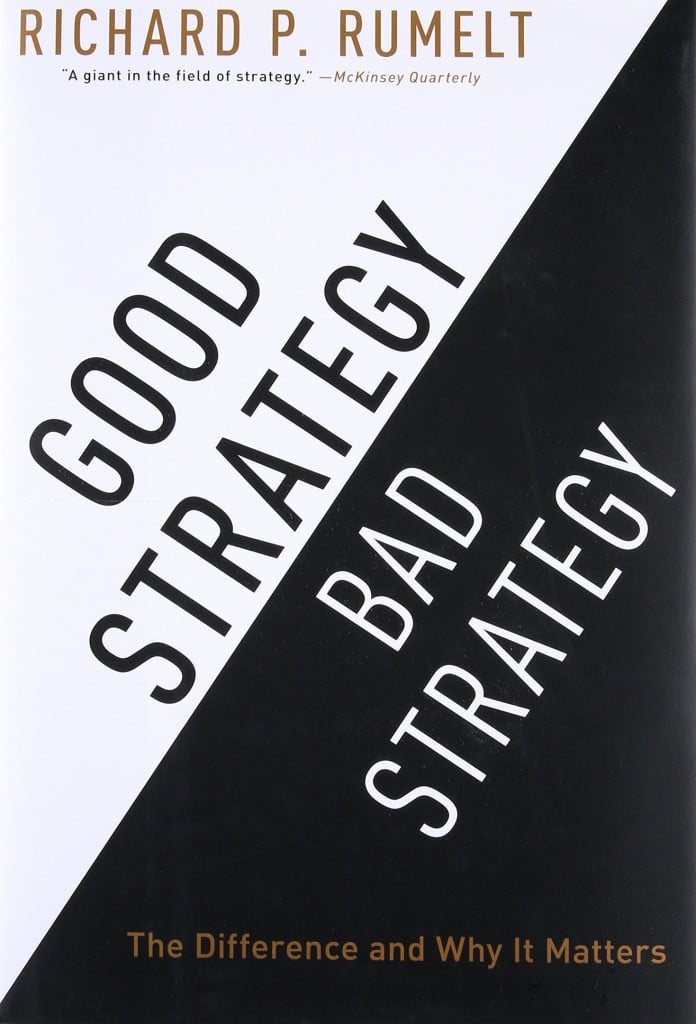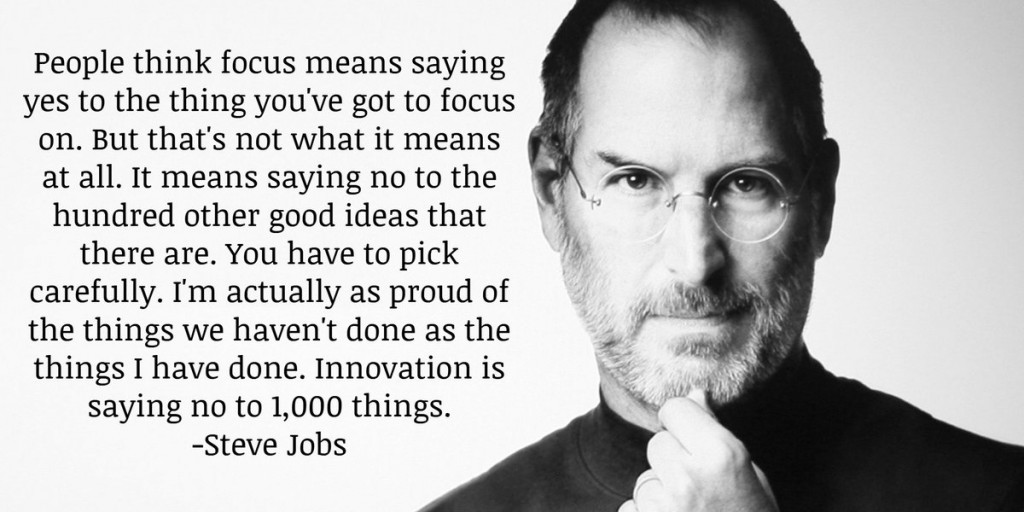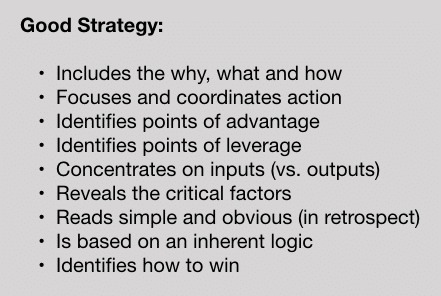Even viral, smash success ads will fail if they’re based on a bad strategy.
- People might remember the entertainment but not your brand
- Or be entertained but not persuaded
- Or left with negative associations regarding your brand
This is why an Uncovery Session and strategic planning have to come before crafting the ads.
“Yeah, that’s great, Jeff, but how do you recognize good strategy from bad?”
 Enter one of the better business books of the last decade: Good Strategy, Bad Strategy: The Difference and Why It Matters.
Enter one of the better business books of the last decade: Good Strategy, Bad Strategy: The Difference and Why It Matters.
It’s well worth the read, but here’s the quick & dirty:
Good strategy always contains three elements and bad strategy doesn’t.
The three elements or “Kernel” of a Good Strategy are:
- A diagnosis of the key challenge or problems to overcoming the goal,
- A guiding policy for effectively overcoming those obstacles
- A set of coherent actions for implementing the policy
In contrast, Bad Strategy will usually:
- Feature an active avoidance of uncomfortable issues.
- Will feel templated rather than custom to your specific company and competitive landscape, and
- Involve nothing but goal setting and “New Thought” style affirmations and/or business buzzwords without specifying specific actions and control of inputs for achieving the goal.
Now let’s look at each of these three defining elements of good strategy, before presenting a streamlined version specific for Advertising Strategy
Diagnosis
Diagnosis defines “what’s standing in your way?”
 If your goal is to grow by multiples, what’s keeping you from that?
If your goal is to grow by multiples, what’s keeping you from that?
If your goal is to attract affluent customers who appreciate quality and convenience and expertise, etc, then why aren’t you attracting those people now?
Is it because people don’t know about you?
Or is it because they do?
Who are those customers currently buying from if they’re not buying from you? And why is that?
If you don’t know what the problem is, you can’t create of decide between guiding policies or actions aimed at overcoming those problems.
And, frankly, with advertising, this point is often avoided because no one wants to tell a client his (or her) baby is ugly.
The temptation is always to “co-sign the client’s crazy” in terms of going along with their inside the bottle thinking, even when a consultant’s outside perspective is one of the most valuable things they can bring to the job.
A Guiding Policy
A good strategy is cohesive.
It will coordinate a company’s actions so that they reinforce and support each other towards overcoming the central, diagnosed obstacle.
To this end, your marketing can’t be out of step with operations, which can’t be out of step with sales, which can’t be out of step with customer support…
For example, if you’re trying to attract dual-income households with active kids, you’ll have to be available at their convenience.
Nine-to-Five probably won’t cut it. Meaning, operations will have to work with advertising.
In contrast, bad strategy often involves priorities or goals that fail to support each other or actively conflict with one another.
When focusing and coordinating efforts, you’ll necessarily have to say “No” to other goals, initiatives, and people that don’t match your main objective.

For example, If you decide to use mass media to position yourself as a premium provider, you’ll have to say “no” to mass mailers for extreme discounts.
If you’ve decided on a strategy based on the reality of externally-triggered purchases, you’ll need to say “no” to advertising tools, tactics, or messaging focused on inducing desire to “buy now.”
In addition, good strategies work by harnessing and applying power where it will have the greatest effect for facing serious challenges and achieving big things fast.
In his book, Professor Rumelt goes into depth analyzing possible sources of power that good strategy can exploit, but if you stick with me, I’ll give you a much more streamlined and usable version.
And if you want the detailed, in-depth analysis, buy the book.
Or hire an expert who’s studied it in depth.
Coherent Actions
 This is where the rubber meets the road.
This is where the rubber meets the road.
Your grand strategy has to translate to action.
Goals are outputs. In order to achieve them, you have to manipulate inputs.
Increasing average ticket price and profit margins might be a goal.
Having techs move through a prescribed set of actions to establish their expertise and trust, before moving on to present multiple, good-better-best options might be an action.
And that action might be combined with a mass media bonding campaign designed to attract higher income customers while creating public trust for the company overall so as to pre-establish credibility for the tech.
The point is that your policy and strategy has to translate down to specific, coherent actions.
Streamlined Strategy for Advertising
When it comes to advertising, I suggest you simplify Rumelt’s kernel to think of strategy in terms of:
- Limiting Factors, and
- Unleveraged Assets
What’s keeping you from growing and being as profitable as you desire?
and
What assets do you have at your disposal for obviating or overcoming those limiting factors?
Now, as an ad consultant, I only work with companies who are already good at what they do.
And typically they are already growing but not as fast as the owner would like.
So their limiting factors tend to cluster around:
- We don’t have enough leads / demand to fuel rapid growth
- We’re getting beat up on price due to low-priced competition
- Our profit margins aren’t where we’d like them
- We need to de-commoditize ourselves and our service/product
- We’re having to educate the customer before selling to them
- Once-burned customers are our best bet, but there aren’t enough of them and/or they’ve already spent their money by the time they find us.
And that leaves Unleveraged Assets.
Most people hear that term and think of “hard” assets, but that’s not usually what I’m looking for.
Sure, occasionally there’s equipment or facilities or technology that can be brought into play, but it’s rare for a competent business owner to leave these things unused to best effect.
More often, unleveraged assets are psychological:
- A powerful Genesis Story that remains untold
- A quality difference that hasn’t been properly marketed
- A differentiating feature that hasn’t been dramatized to maximum effect
- Powerful customer testimonials that haven’t been collected and featured in ads
- Moving from extortionately priced PPC to economical mass media in order to brand an ugly duckling business
Keep in mind that I’m not saying that powerful storytelling IS the strategy.
I’m saying that powerful stories are a commonly found unleveraged asset that can be used to help implement the strategy.
The Bottom Line to Strategy
If you want your ads to work, they’ll need to be part of a campaign based on sound strategy.
And your ads won’t be based on sound strategy, unless your ad consultant takes the time to formulate one before making the ads.
So the best strategy I can recommend to you is to hire a consultant who does exactly that.
- Are You Paying for Too Much for the Wrong Keywords? - July 15, 2024
- Dominate Your Market Like Rolex — 4 Powerful Branding Lessons - July 3, 2024
- Military-Grade Persuasion for Your Branding - June 25, 2024
